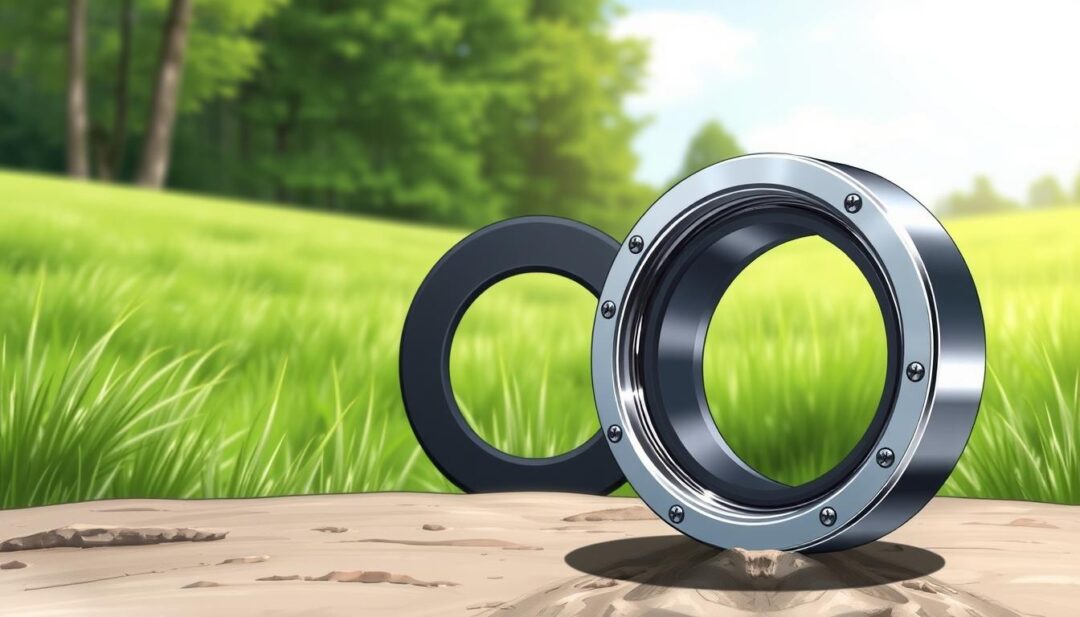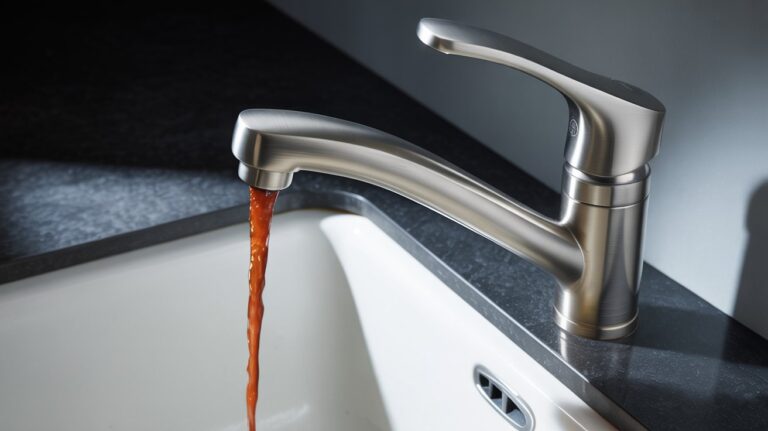What is a Well Cap?
Have you ever wondered how to protect your water well from contaminants and unwanted critters?
A well cap is a crucial component that serves as the first line of defense. It is designed to seal the top of the well casing, preventing debris, animals, and other foreign objects from entering the well.
The importance of a well cap cannot be overstated. It not only safeguards the water quality but also ensures the longevity of the well by preventing damage from external elements.
Key Takeaways
- A well cap is essential for protecting the well from contaminants.
- It prevents animals and debris from entering the well.
- A well cap is crucial for maintaining water quality and well longevity.
What is a Well Cap and Why is it Important?
A well cap is more than just a cover; it’s a critical barrier that safeguards your well water. Understanding the well cap purpose and its definition is crucial for appreciating its role in well maintenance.
Definition and Basic Function
A well cap, by well cap definition, is a device that seals the top of a well casing, preventing external contaminants from entering the well. Its basic function is to protect the well from surface water, debris, and animals that could compromise water quality.
The well cap serves as the first line of defense against pollution, ensuring that the water drawn from the well is safe for use. It is designed to fit securely over the well casing, creating a tight seal that prevents unwanted entries.
The Critical Role in Well Protection
The well cap plays a vital role in well protection by:
- Preventing surface contaminants from entering the well
- Keeping animals and debris out
- Reducing the risk of waterborne pathogens
By fulfilling these roles, the well cap ensures the well remains a safe and reliable source of water.
Consequences of a Missing or Damaged Cap
A missing or damaged well cap can have serious consequences, including:
- Contamination of the well water
- Increased risk of waterborne diseases
- Potential for costly repairs or remediation
It is essential to inspect the well cap regularly and replace it if necessary to avoid these issues.
Components of a Well Cap
Understanding the components of a well cap is crucial for ensuring the overall integrity of your well. A well cap is not just a simple cover; it’s a sophisticated system designed to protect your well from various contaminants and elements.
Main Parts and Materials
The main parts of a well cap include the lid, base, gaskets, and seals. The lid and base construction are typically made from durable materials such as stainless steel, plastic, or cast iron, chosen for their resistance to corrosion and ability to withstand environmental conditions.
Lid and Base Construction
The lid and base of a well cap are designed to fit securely over the well casing, providing a tight seal. The construction materials are selected based on factors like durability and resistance to corrosion. For instance, a well cap’s lid might be made from stainless steel for its strength and resistance to rust.
Gaskets and Seals
Gaskets and seals play a critical role in ensuring the well cap is properly sealed. They are usually made from rubber or other flexible materials that can compress to fill any gaps, thus preventing water and contaminants from entering the well. As noted in a guide on well caps, “a proper seal is essential for maintaining the quality of the well water” Your Well Cap.
Venting Systems
Venting systems are another crucial component of a well cap, allowing for the release of air and gases while keeping contaminants out. The design of the venting system can vary, with some well caps featuring screened vents to prevent the entry of insects and debris.
Electrical Conduit Openings
For wells that are equipped with electrical pumps, the well cap may include openings for electrical conduits. These openings are designed to be sealed once the conduit is in place, maintaining the overall seal of the well cap and protecting the electrical components from the elements.
By understanding the various components of a well cap, well owners can better appreciate the importance of maintaining their well cap and ensuring it functions as intended.
Types of Well Caps Available
Well caps come in a range of styles and functionalities, designed to meet the diverse requirements of different well types and environments.
Standard Well Caps
Standard well caps are the most basic type, designed to cover and protect the well casing. They are typically made from durable materials such as steel or cast iron and are suitable for most well configurations.
Sanitary Well Caps
Sanitary well caps are designed with a focus on hygiene and are often used in wells that supply water for drinking or other potable uses. They feature a tight seal to prevent contamination and are typically made from materials that are resistant to corrosion.
Vented Well Caps
Vented well caps allow for airflow into the well, which can be crucial for certain types of wells, such as those used in agricultural settings. The venting helps to regulate pressure and can prevent damage to the well casing.
Vermin-Proof Well Caps
Vermin-proof well caps are designed to prevent animals from entering the well. They feature screens or other barriers that keep rodents, snakes, and other small animals out, protecting the well from potential contamination.
Decorative and Specialty Well Caps
For wells located in residential areas or visible landscapes, decorative well caps offer a way to blend the well infrastructure into the surroundings. These caps come in various designs and can be chosen to match or complement the local architecture or landscaping. For more ideas on integrating well infrastructure into your home’s design, visit Discover the Best Well Water Cover Ideas for Your.
| Type of Well Cap | Primary Feature | Typical Use |
|---|---|---|
| Standard | Basic protection | Most well configurations |
| Sanitary | Tight seal for hygiene | Potable water wells |
| Vented | Allows airflow | Agricultural or industrial wells |
| Vermin-Proof | Prevents animal entry | Wells in areas with wildlife |
| Decorative/Specialty | Aesthetic appeal | Residential or visible areas |
Well Cap vs. Well Seal: Understanding the Difference
The terms ‘well cap’ and ‘well seal’ are often used interchangeably, but they serve distinct purposes in well protection. Understanding their differences is crucial for maintaining the integrity and safety of your well.
Functional Differences
A well cap is designed to protect the well casing from external contaminants such as debris, animals, and precipitation. It fits over the top of the well casing, providing a barrier against surface pollutants. On the other hand, a well seal is typically used to seal the well casing at the top, often incorporating electrical conduit openings for wiring to the pump. While both components are vital, they serve different functions in safeguarding the well.
The primary function of a well cap is to prevent physical intrusion and contamination, whereas a well seal focuses on sealing the well casing, often with provisions for electrical connections. This distinction is critical in understanding how each component contributes to the overall protection of the well.

When to Use Each Type
The choice between a well cap and a well seal depends on the specific requirements of your well system. For instance, if your well is located in an area prone to flooding or where animals might access the well casing, a robust well cap might be the preferred choice. Conversely, if the primary concern is sealing the well casing while allowing for electrical connections, a well seal would be more appropriate.
It’s also worth noting that some well systems may utilize both a well cap and a well seal, depending on the design and local regulations. In such cases, the well cap might be used over the well seal to provide an additional layer of protection.
Compatibility with Different Well Types
Both well caps and well seals come in various designs to accommodate different types of wells, including drilled wells, dug wells, and bored wells. The material and design of these components should be compatible with the well type and local environmental conditions. For example, a well cap for a well in a corrosive environment might be made from durable, corrosion-resistant materials.
Understanding the specific needs of your well, including its type and environmental exposure, is key to selecting the right well cap or well seal. Consulting with a well professional can help determine the best well cap practices for your specific situation, ensuring the longevity and safety of your well.
Selecting the Right Well Cap for Your Well
Selecting a well cap that meets your well’s specific needs is essential for optimal performance. The process involves considering several key factors that directly impact the well’s functionality and longevity.
Measuring Your Well Casing
The first step in choosing the right well cap is to accurately measure your well casing. This ensures a proper fit, which is crucial for preventing contamination and ensuring the cap functions as intended. To measure your well casing, you will need to determine its diameter and the type of threading it has, if any.
Accurate measurements are critical to selecting a well cap that fits properly. An ill-fitting cap can lead to operational issues and potentially compromise the well’s safety.
Material Considerations
The material of the well cap is another critical factor. Different materials offer varying levels of durability, resistance to corrosion, and compatibility with different types of well casings. Common materials include stainless steel, plastic, and cast iron. The choice of material should be influenced by the types of well caps available and their characteristics.
| Material | Durability | Corrosion Resistance |
|---|---|---|
| Stainless Steel | High | Excellent |
| Plastic | Medium | Good |
| Cast Iron | High | Poor |
Climate and Environmental Factors
Climate and environmental conditions play a significant role in determining the best well cap for your well. For instance, areas with extreme temperatures or high levels of precipitation may require well caps with additional features such as venting systems or enhanced sealing mechanisms.
Consider the environmental conditions around your well when selecting a cap. This includes factors such as exposure to sunlight, flooding potential, and the presence of wildlife that could compromise the cap.
Budget Considerations
Finally, your budget will also influence the selection of a well cap. While it’s essential to invest in a high-quality cap that meets your well’s needs, there are options available across a range of price points. Balancing cost with the required features and durability is key to making the right choice.
When considering your budget, also factor in the potential costs associated with well cap installation. Professional installation may add to the upfront cost but can provide long-term benefits in terms of well safety and performance.
Installing a Well Cap: Step-by-Step Guide
To protect your well from contaminants and ensure its optimal functioning, a proper well cap installation is essential. This guide will walk you through the process, highlighting the necessary tools, preparation steps, and the installation itself.
Tools and Materials Needed
Before starting the installation, gather the required tools and materials. These typically include the well cap itself, a wrench or socket for tightening, and potentially a new gasket or sealant for ensuring a watertight seal.
Essential Tools:
- A well cap compatible with your well casing
- Adjustable wrench or socket
- Gasket or sealant
- Teflon tape (for threaded connections)
Preparation Steps
Preparation is key to a successful well cap installation. Begin by turning off the power to the well pump and ensuring the area around the well casing is clear of debris.
Important Preparation Steps:
- Shut off the power to the well pump
- Clear the area around the well casing
- Inspect the well casing for any damage or debris
Installation Process
The installation process involves placing the well cap over the casing, ensuring a secure and watertight fit. Use your wrench or socket to tighten the cap according to the manufacturer’s instructions.
Professional vs. DIY Installation
While a well cap installation can be a DIY project for those with experience, it’s often recommended to hire a professional to ensure the job is done correctly and safely.
Considerations for DIY Installation:
- Experience with similar projects
- Understanding of local regulations and best practices
- Access to the necessary tools and materials
Common Installation Mistakes to Avoid
Avoid common pitfalls such as overtightening, which can damage the cap or casing, and failing to ensure a watertight seal, which can lead to contamination.
Mistakes to Avoid:
- Overtightening the well cap
- Not using a gasket or sealant
- Failing to inspect the well casing before installation
Maintaining Your Well Cap
Maintaining your well cap is a simple yet effective way to protect your well from potential contaminants. A well-maintained well cap ensures the longevity and safety of your well, preventing costly repairs and potential health risks.
Regular Inspection Routine
Regular inspections are crucial for identifying any potential issues with your well cap. It’s recommended to inspect your well cap at least twice a year, checking for signs of wear, damage, or corrosion.
- Check the cap for any cracks or breaks.
- Inspect the venting system for blockages or damage.
- Ensure all electrical conduit openings are sealed properly.
Cleaning Procedures
Cleaning your well cap is an essential part of its maintenance. Use a mild detergent and water to clean the cap, avoiding harsh chemicals that could damage the materials.
Step-by-Step Cleaning Guide:
- Remove any debris or dirt from the cap’s surface.
- Mix a solution of mild detergent and warm water.
- Gently scrub the cap with a soft-bristled brush.
- Rinse thoroughly with clean water.
- Dry the cap to prevent water spots.
Seasonal Maintenance Tips
Different seasons bring different challenges for your well cap. Here are some seasonal maintenance tips:
| Season | Maintenance Task |
|---|---|
| Spring | Inspect for damage from winter, clean the cap, and check the venting system. |
| Summer | Check for signs of overheating and ensure the cap is securely locked. |
| Fall | Prepare the well cap for winter by inspecting and repairing any damage. |
| Winter | Ensure the cap is protected from freezing temperatures and snow accumulation. |
Troubleshooting Common Issues
Despite regular maintenance, issues can still arise. Here are some common problems and their solutions:
Issue 1: Leaks or Cracks – If you notice any leaks or cracks, inspect the cap for damage and replace it if necessary.
Issue 2: Blocked Venting System – Clean the venting system to ensure proper airflow and prevent blockages.
By following these maintenance tips and troubleshooting common issues, you can ensure your well cap remains in good condition, protecting your well and ensuring its longevity.
Regulatory Requirements for Well Caps
Compliance with well cap regulations is not just about avoiding penalties, it’s about ensuring the safety and quality of your water supply. Well caps are subject to various regulations that can vary significantly depending on the jurisdiction.
National Standards and Certifications
At the national level, there are standards and certifications that govern the manufacture and installation of well caps. These standards often relate to materials, design, and performance. For instance, well caps must be able to withstand environmental conditions and prevent contamination of the well.
Key national standards include:
- Materials that are durable and resistant to corrosion
- Designs that prevent water ingress and contamination
- Performance metrics that ensure the cap can withstand environmental stresses
State-Specific Regulations
State-specific regulations for well caps can be quite detailed, often requiring compliance with local health and environmental standards. For example, in Texas, the Texas Groundwater Protection Committee provides guidelines on well capping, including materials and installation practices.
| State | Regulatory Body | Key Requirements |
|---|---|---|
| Texas | Texas Groundwater Protection Committee | Specific guidelines on materials and installation |
| California | California Department of Water Resources | Standards for well construction and maintenance |
| New York | New York State Department of Environmental Conservation | Regulations on well drilling, construction, and abandonment |
Local Code Compliance
Local codes and ordinances also play a significant role in regulating well caps. These can include zoning regulations, health codes, and environmental ordinances. Compliance with local codes is crucial to avoid fines and ensure the well operates safely.
It’s essential to check with local authorities for specific requirements.
Working with Well Inspectors
Well inspectors are critical in ensuring that well caps comply with regulatory requirements. They assess the condition and integrity of the well cap, checking for signs of damage, wear, or potential contamination sources.
Best practices when working with well inspectors include:
- Ensuring access to the well cap and surrounding area
- Providing documentation on the well cap’s materials and installation
- Addressing any issues or recommendations made by the inspector promptly

Conclusion
A well cap is a crucial component of a well system, serving as the first line of defense against contamination and damage. Understanding what is a well cap and its purpose is essential for maintaining a safe and functional well.
Throughout this article, we’ve explored the different types of well caps, their components, and the importance of proper installation and maintenance. Selecting the right well cap for your well is vital to ensure its longevity and the quality of the water it provides.
By following the guidelines outlined in this article, you can effectively choose, install, and maintain a well cap that meets your needs and complies with regulatory requirements, thus protecting your well and the environment.







